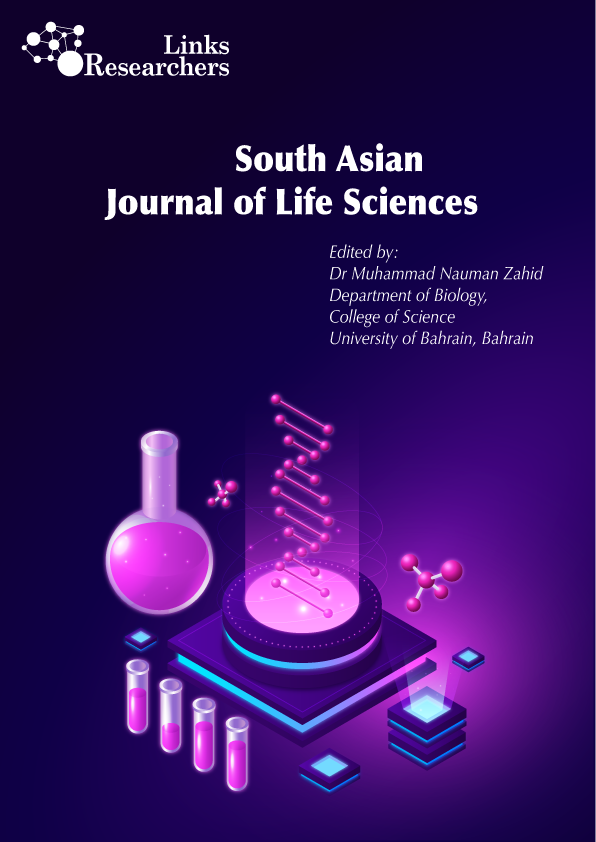Dipak Mandal, Paramita Bhowmik, Pronobesh Halder and M. L. Chatterjee
Jawad Anwar* and Zafar Iqbal
Zaheer Abbas*, Shaukat Ali, Jalal-Ud-Din and Ghulam M. Ali*
Abdul Basit1, Muhammad Zeeshan Majeed1,4*, Sohail Ahmed2, Gohar Ali2 and Muhammad Javaid3
Muhammad Asam Riaz1, Javeria Choudhary1, Muhammad Zeeshan Majeed1*, Muhammad Afzal1, Sohail Ahmed2 and Muhammad Sajjad Khalil1
Muhammad Latif2, Muneer Abbas1*, Faisal Hafeez2 and Dilbar Hussain2
Nasir Raza Zaidi1, Mian Waheed Ahmad1, Mahesh Gautam1, Riffat Mehboob2*
and hypovitaminosis D as frequently associated with MS....
Muhammad Moosa Abro1, Ali Murtaza Dharejo2, Muhammad Munif Khan2, Nadir Ali Birmani2, Saima Naz2*
Muhammad Shahzad Akbar, Muhammad Zeeshan Majeed* and Muhammad Afzal
Muhammad Naeem Khan* and Asad Jan
Muhammad Rehan3, Asim Aslam3, Javeria Umber4, Muti-ur-Rehman Khan3, Waqar Azeem3, Hassan Aftab5, Ahsan Anjum3, Muhammad Abid6, Abdul Hameed Khan3, Hafiz Hasnain Ayoub5, Altaf Hussain2 and Muhammad Farooq Khalid1*
Asmaa Abdallah Darwish
Abdiaziz Idiris Mohamud1, Yonis Abukar Mohamed2, Osman Sheikh Ali Jama3, Pravin Mishra4* and Mohamed Idiris Mohamed5
Mahmoud Mohamed Ahmed Youssef* and Suzan Abd-Elazeim Hassabo
Muhammad Yasir*, Mansoor ul Hasan, Muhammad Sagheer, Amer Rasul, Rameesha Amjad Ali and Habib ur Rehman
Muhammad Ibrahim Kubar1, Fahad Nazir Khoso1*, Imran Khatri1, Niaz Hussain Khuhro2 and Arfan Ahmed Gilal1
Muhammad Usman Hanif, Abu Bakar Muhammad Raza, Muhammad Zeeshan Majeed*, Muhammad Arshad, Muhammad Irfan Ullah
Adel M. Abdelrahman1, Sahar R. Mohamed1, Soliman M. Soliman2, Sherif Marouf3*
Stephen Chijioke Emencheta1, Chinelo Charity Eze1, Anthony Amaechi Attama2, Damian Ejike Agbo1 and Ebele Benedette Onuigbo1*
Neda Amani1, Mehrdad Shariati1, Rahim Ahmadi2,3*, Mokhtar Mokhtari1 and Saeed Khatamsaz1
Kanakuntla Sandhyarani*, Dhoppalapudi Madhuri, Yadala Ravikumar
Mariam Arain1, Asghar Ali Kamboh1* and Muhammad Javed Arshed2
Tiyyabah Khan1, Hafiz Azhar Ali Khan1*, Muhammad Rizwan Khan1, Muhammad Umer1, Adnan Akhter1 and Waseem Akram2
Wei Cui1, Yanwei Du1, Lijuan Jiang1, Yan Wei1, Yuguo Li1, Wenfeng Zhang1* and Ling Zhang2*
Ghulam Murtaza1,6*, Muhammad Irfan Fareed2, Noshaba Munawar3, Muhammad Nadeem Khan4, Gul-E- Zahra5, Taskeen Ahmad6, Muhammad Daud6 and Taqi Raza6
Mehwish Saleem Khan* and Sumama Farooq
Muhammad Ajmal Khan1, Muhammad Yahya2*, Ali Hazrat2, Javed Khan3, Saeed Jan4, Tabinda Nowsheen2 and Inam Ullah5
Ochieng Onunga George*, Owuor Ndonga Millicent Florence, Mario Kollenberg
Hanan Saad El-Samahy, Amani Abd El-Naby Hafez, Mohamed Talat Ragab, Disouky Mohamed Mourad*
Bilal Dik1, Saima Naz2*, Muhammad Sohail Sajid3,4
Syed Ishfaq Ali Shah1,3, Azaz Ahmad2 and Wanzhi Cai1,*
Hanaa H.A. Gomaa1*, Dalia Y.Z. Amin1, Mona A. Ismail1 and Khalid A. El-Dougdoug2
Reda Hassan*, Bahaa Abou-shehema, Sherif Zayed, Micheal Gorgy, Shama Morsy, El-Sayed Abu El-Hassan, Mahmoud El-Gbaly, Hanaa Basuony, Ebtehal Hassan
Uzma Hameed1*, Aneela Liaqat1, Muhammad Asjad Khan2, Ikram-Ul-Haq1 and Maham Aslam1
Öznur Özil*, Öznur Diler, Mevlüt Nazıroğlu, Aşkın Atabay
Nadia A Eltablawy1, Ibrahim El Tantawy El Sayed2, Hamed Mohamed Abdel Barry2, Marwa A. Ibrahim3*, Maha Nageib Ahmed Serag ElDein2
A.W. Amin†, A.A. Anter, A.H. Ashoub* and A.S. El-Nuby*
Nuzhat Munawar1, Abrar Hussain1, Imran Sajid2, Zahra Noreen1, Muhammad Aslam3*, Zeeshan Rehman1 and Aamir Ali3,4
B. Archana and R. Saxena
Hidayat Ullah1, Sadia Tabassum1, Sultan Ayaz2, Shumaila Noreen1, Atta Ur Rehman1, Naveed Akhtar3, Muhsin Ali3, Zaib Ullah3* and Sajid Mahmood1,4
Noor Rahmawati, Alfi Rumidatul* and Sopandi Sunarya
Hanaa M. Abdelkhalek1, Hanan E. Nagib1, Randa S. Elias1, Saad S. Mansour1, Walid S. Mousa2*
A. S. Gamal El din1; Sohair I. El-Afifi2; A. S. Sadik2; Nashwa M. A. Abd El Mohsen1; and H. M. Abdelmaksoud1
Rafik Soliman1*, Rafik H. Sayed2, Hanan Mahmoud3, Heidy Abo El-Yazeed1, Marsell Saad1, Shaimaa Abdelall Elsaady2, Khalid Sh3
Altaf Ur Rahman1, Muhammad Ajmal Khan2*, Ali Hazrat3, Awais Farid4, Muhammad Yahya3* and Inam Ullah5
Mohammad Bani Ismail
Jameel-ur-Rehman1, Asghar Ali Kamboh1*, Ahmad Ali Moryani1, Riaz Ahmed Leghari1, Abdullah Sethar2, Ali Raza Nizamani3, Abdul Ahad Soomro3, Kanwar Kumar Malhi1
Iftikhar Ahmad1, Tahir Saeed1, Umair Faheem2*, Qaisar Abbas2, Muhammad Saleem Akhtar Khan3, Mussurrat Hussain2, Tanveer Ahmad4, Gulzar Akhtar4, Asifa Hameed5, Muhammad Hasnain6 and Muhammad Jamil7
Amina A. II. and M.K. Amin
Divanildo Outor-Monteiro1,2,3*, José António Silva2,3,4, José Luís Mourão1,2,3, Victor Pinheiro1,2,3
Tabinda Nowsheen1, Sayed Wadood Ali Shah2, Ali Hazrat1*, Muhammad Yahya1, Gul Rahim1, Muhammad Mukhtiar4 and Muhammad Ajmal Khan3
Ghaith Z. Hasan Al-Askari *, Eman H. Yousif Al-Taee
IRFANA IQBAL1*, PAKEEZA TANWEER1, FARKHANDA MANZOOR1, MUHAMMAD NAUMAN AFTAB2, AFSHAN KALEEM3, ROHEENA ABDULLAH3, ASMA ZAFAR4 & MEHWISH IQTEDAR3
HANNANA MARYAM, SANA MAQSOOD & SIKANDER ALI*
Shabana Islam1, Shahida Shujaat1*, Erum Akbar Hussain1, Mateen Abbas2
Md. Asaduzzaman Lovelu1, Md. Amir Hossain2*, Md. Uzzal Hossain1, Tanzila Zafrin Tanvi1, Mahfuza Ferdous3, Nazmin Sultana Runa4, Assrafi Siddika3, Md. Sahidul Islam2
Suhair Sh. Al-Siraj1, Jihan M. Badr2 and Dalia M.A. El-Masry3*
Roy Sukbir Singh1, Jekson Martiar Siahaan2,3*, Endy Juli Anto4, Syafruddin Ilyas5, Putri Eyanoer6, Hendrika Andriani7,8
Ali Abd Kadhum
Sumaya Loay Mohamed Shams Al-Dean1*, Sura Shakir Hammoud2, Mohammedali J. Ghafil3
Eman Mamdouh Qenawy1, Mohamed Abou-Ellail1, Fatma Abdel-Motaal2, Mohammed O. Alshaharni3, Nady Khairy Elbarbary4*
Sana Eijaz, Asmat Salim* and Mohammad Anwar Waqar
Baraa Qasim Mohammed1, Asmaa Hamoody Abdullah1, Ahmed Raheem Rayshan2*
Ye-Ling Lao, Jin-Long Huang, Cheng-He Sun, Xiao-Ying Huang, Ting Wu and Qun Zhang*


















